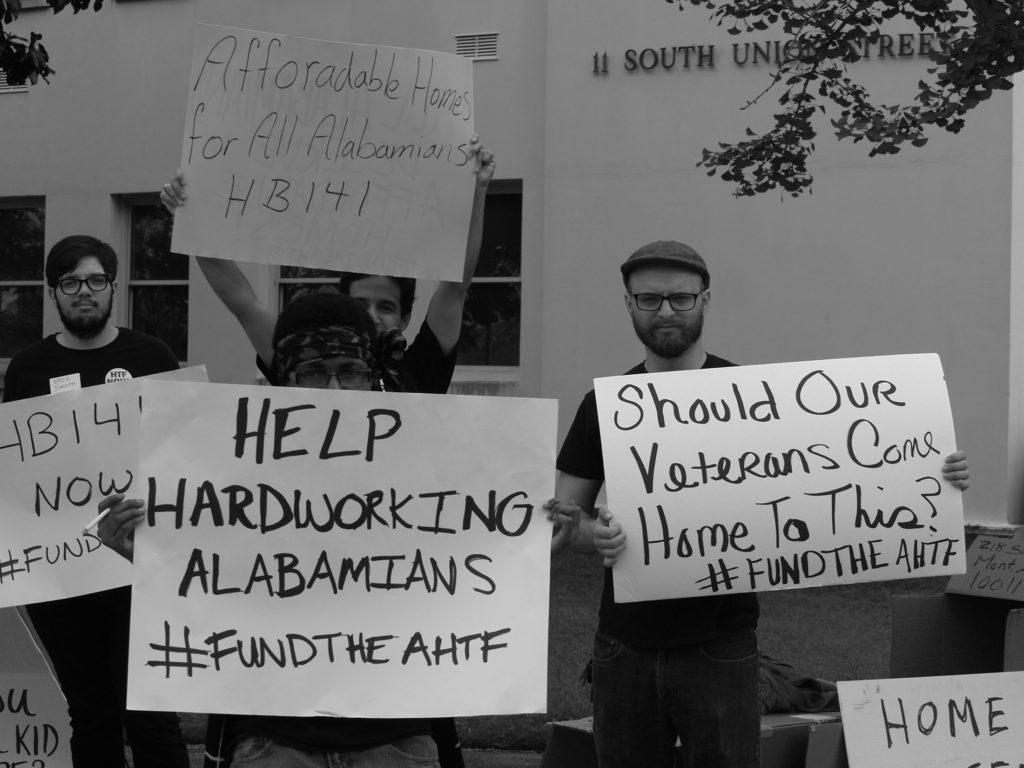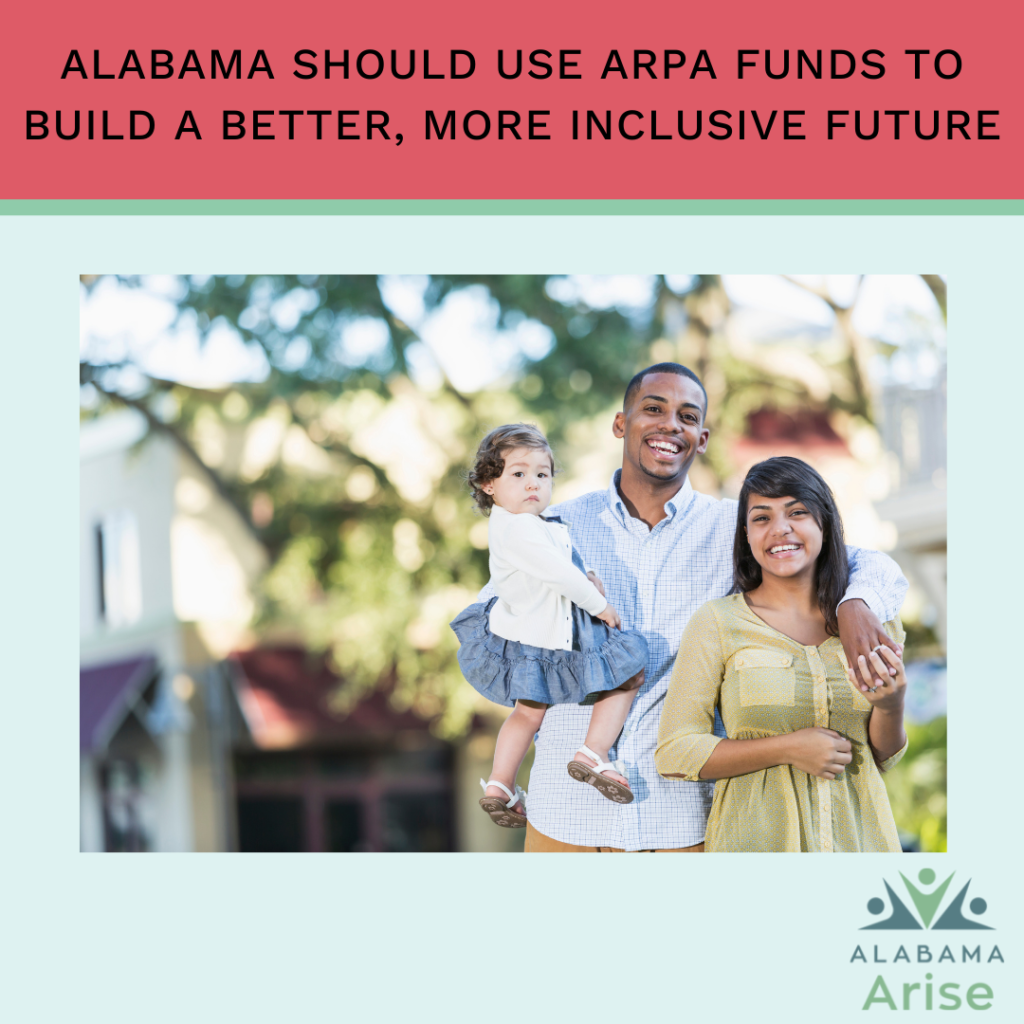The Alabama Legislature has stepped away briefly from its regular session for a special session on federal COVID-19 relief funds. Arise executive director Robyn Hyden provides an overview of how lawmakers plan to allocate the next portion of American Rescue Plan Act (ARPA) money this week. And she explains why affordable housing and public transportation should be among the top priorities for the next round of ARPA funding.
Issue: Housing
New poll: Alabamians strongly support use of ARPA funds to protect rural hospitals, increase mental health services
Alabama’s likely voters overwhelmingly support using federal COVID-19 relief funds to increase funding for mental health and rural hospitals, according to a new Alabama Arise poll released Monday.
More than four in five respondents (81.1%) supported using a portion of Alabama’s funding under the American Rescue Plan Act (ARPA) to invest in rural hospitals and increase rural Alabamians’ access to health care. And nearly three in four likely voters (73.6%) said lawmakers should boost mental health funding to increase access to services across Alabama. Among Republican voters, 80.1% supported investments in rural hospitals and 67.7% supported more mental health care funding.
“Alabamians are loud and clear that they want our lawmakers to use federal relief money to strengthen our state’s health care system,” Alabama Arise executive director Robyn Hyden said. “The COVID-19 pandemic has strained health care workers like nothing before in our lifetimes. And it has exposed and worsened our state’s persistent racial and geographic health disparities.
“ARPA offers an unprecedented chance to protect rural hospitals and increase access to mental health care and other services. We must seize this opportunity to build a healthier future for Alabama.”
Child care, housing, public transportation also enjoy strong public support
Sizable majorities also approved of other potential uses of ARPA money to improve living conditions for Alabama’s children and families. Those proposals include:
- Expanding access to subsidized child care for working families.
- Establishing a state child tax credit to lower costs for working families.
- Expanding access to affordable housing throughout the state.
- Investing in public transportation, particularly in rural areas.
Alabama will receive a total of more than $2 billion in ARPA funds. Lawmakers last year appropriated $400 million of that amount toward prison construction and $80 million to hospitals and nursing homes. This week, the Legislature will vote on a plan to spend another $772 million of ARPA funds. Most of that money would go toward broadband internet expansion, water and sewer improvements, and additional funding for hospitals, nursing homes and assisted living facilities.
The state expects to receive the remaining $1 billion in ARPA funds later this year. Arise’s poll shows the public wants legislators to use that money to ease economic stress on Alabama households, Hyden said.
“The pandemic has made it harder for people across our state to find child care, keep a roof overhead and get where they need to go,” Hyden said. “We should use ARPA funding to ease families’ suffering and provide the supports needed to help every Alabamian succeed. It’s time for our lawmakers to meet this moment and ensure Alabama’s post-pandemic future is a bright and inclusive one.”
About the survey
Alabama Arise commissioned the poll, which the Montgomery-based firm Cygnal conducted Jan. 13-14. The poll surveyed 631 likely voters across Alabama and has a margin of error of +/- 3.85%. Interviews of known registered voters occurred via live phone calls, online panel, texts and email invitation.
Click here for Arise’s poll results on ARPA funding priorities in Alabama.
Six ways Alabama should use ARPA funds to build a better, more inclusive future
The Alabama Legislature’s 2022 regular session, which began Tuesday, will be unusual in one important way. For the first time in many years, Alabama has more than enough revenue to maintain its bare-bones public services. That means instead of scrambling to avoid cuts, the legislative focus can be on strengthening investments in our state’s future.
Both the Education Trust Fund (ETF) budget and the General Fund (GF) budget, which funds non-education programs, have seen tax revenues rise more than 10% in the last year. ETF revenues actually increased 16% in 2021. In addition, Alabama has about $1.6 billion of federal relief funds remaining under the American Rescue Plan Act (ARPA). President Joe Biden signed ARPA into law in March 2021.
Alabama lawmakers already allocated $480 million of the state’s ARPA money last year. Of that amount, $400 million went toward prison construction and $80 million went to hospitals and nursing homes.
Budget growth faces sustainability challenges
State budget officials have steadily cautioned lawmakers to consider the one-time nature of both relief money and the bump in tax revenues. Recent revenue growth almost certainly will not be sustained in future years, budget officials warn. And one-time ARPA funds are by definition only temporary.
Alabama’s budget officials have strongly recommended that both ARPA funds and increased state revenues be invested in programs and services that won’t require regular, recurring revenue but that still meet critical needs for the people of the state. Alabama Arise questions whether the new revenue is as unsustainable as budget officials predict. But Arise agrees that this money needs to fund big ideas that will benefit the state for years to come.
Areas for investment
If spent wisely, ARPA funds could create vital long-term improvements for Alabamians. Alabama Arise has numerous specific suggestions for what those big ideas, and investments, could be.
Serve underserved communities
 ARPA investments should focus on the most underserved areas and most underserved Alabamians. Communities of color and communities with low incomes, particularly in the Black Belt, have long-festering unmet infrastructure needs. The lack of wastewater treatment, accessible broadband internet, affordable housing and public transportation has held these communities back for decades.
ARPA investments should focus on the most underserved areas and most underserved Alabamians. Communities of color and communities with low incomes, particularly in the Black Belt, have long-festering unmet infrastructure needs. The lack of wastewater treatment, accessible broadband internet, affordable housing and public transportation has held these communities back for decades.
In deciding where to spend new one-time dollars, the most historically neglected parts of Alabama should come first. An urgent public health need in many rural Black Belt counties is for sewer and other water treatment systems. These should be a top priority.
Modernize state technology
 A major lesson from the COVID-19 recession was that Alabama’s technology infrastructure is totally inadequate for remote access to services. Suddenly unemployed people desperately tried to apply for unemployment insurance (UI) benefits, food assistance, COVID-19 tests and other services on overwhelmed state computer and telephone systems. People who had never before applied for public assistance couldn’t find one-stop sources of information about services for which they might be eligible. And when new federal programs were created, they were hard to implement. That’s because Alabama’s computer systems didn’t talk to each other and couldn’t share information needed to help people get assistance.
A major lesson from the COVID-19 recession was that Alabama’s technology infrastructure is totally inadequate for remote access to services. Suddenly unemployed people desperately tried to apply for unemployment insurance (UI) benefits, food assistance, COVID-19 tests and other services on overwhelmed state computer and telephone systems. People who had never before applied for public assistance couldn’t find one-stop sources of information about services for which they might be eligible. And when new federal programs were created, they were hard to implement. That’s because Alabama’s computer systems didn’t talk to each other and couldn’t share information needed to help people get assistance.
Modernizing the state’s computer systems would be a great investment to increase efficiency and prepare us for the next crisis. This would allow for integrated eligibility and data sharing systems across state agencies. And it would be an opportunity to modernize and upgrade the state’s UI application and payment process.
Expand Medicaid and strengthen public health
 Alabama has failed for decades to invest adequately in our health care infrastructure, including Medicaid. The devastating toll of the COVID-19 pandemic has made the consequences of that failure apparent to everyone in the state. We need to invest now in a health care infrastructure that will improve the delivery of health services to underserved individuals and communities.
Alabama has failed for decades to invest adequately in our health care infrastructure, including Medicaid. The devastating toll of the COVID-19 pandemic has made the consequences of that failure apparent to everyone in the state. We need to invest now in a health care infrastructure that will improve the delivery of health services to underserved individuals and communities.
Medicaid expansion to cover adults with low incomes is an essential step to strengthen Alabama’s health care system. Other investments should include more funding for mobile health services and telehealth services. Alabama also should provide additional resources for our local and state public health departments.
Reduce hunger and promote healthier communities
 Hunger was already a large and perpetual problem across Alabama even before the pandemic. But the COVID-19 recession and its aftermath exacerbated this problem by fueling a rapid, major increase in food insecurity. Sudden income loss, rising prices and occasional shortages have made it much more difficult for many people to feed their children and families.
Hunger was already a large and perpetual problem across Alabama even before the pandemic. But the COVID-19 recession and its aftermath exacerbated this problem by fueling a rapid, major increase in food insecurity. Sudden income loss, rising prices and occasional shortages have made it much more difficult for many people to feed their children and families.
The Supplemental Nutrition Assistance Program (SNAP) and various child nutrition programs are essential standing resources to fight hunger in Alabama. But the state can and should do more to support our food infrastructure. Alabama should provide healthy food financing grants to expand community groceries, farmers markets and mobile markets. This would improve access to healthy foods in communities without ready access to fresh foods, especially fruits and vegetables.
Invest in affordable housing
 The COVID-19 recession has caused a wave of evictions and foreclosures across Alabama. This has occurred as the cost of housing has been driven up amid supply chain issues and fewer available workers.
The COVID-19 recession has caused a wave of evictions and foreclosures across Alabama. This has occurred as the cost of housing has been driven up amid supply chain issues and fewer available workers.
Alabama could help address its housing shortage and resulting homelessness by providing $25 million for the state Housing Trust Fund. This investment would create and support jobs across the state. And it would reduce Alabama’s shortfall of more than 73,000 affordable homes for people with incomes below the federal poverty level.
Fund public transportation
 Alabama’s elected leaders, including Gov. Kay Ivey in her State of the State address, have celebrated the state’s low unemployment rate. But they also are bemoaning our state’s associated low rate of labor force participation. For more Alabamians to return to work during and after the pandemic, the state must ensure they have essential work supports. Not the least of these is transportation to and from a job or school.
Alabama’s elected leaders, including Gov. Kay Ivey in her State of the State address, have celebrated the state’s low unemployment rate. But they also are bemoaning our state’s associated low rate of labor force participation. For more Alabamians to return to work during and after the pandemic, the state must ensure they have essential work supports. Not the least of these is transportation to and from a job or school.
Lawmakers can help people reenter the job market by investing $20 million in ARPA funds and $10 million in GF dollars in the state Public Transportation Trust Fund. These dollars would go a long way toward ensuring that people, especially those in rural areas, can get to a job and to job training. They also would help Alabama match other federal transportation dollars that can benefit the entire state.
Alabama Housing Trust Fund can help thousands find a place to call home
Alabama lacks more than 73,000 homes for households with incomes below the federal poverty line ($26,500 for a family of four). That means many seniors, students, veterans and people with low or fixed incomes in Alabama can’t afford a safe place to call home. And the pandemic only made the housing crisis worse. Between Sept. 29 and Oct. 11, more than 28,000 Alabama families told the U.S. Census Bureau that they expected to be evicted from their current home because they couldn’t pay the rent.
State support for the Alabama Housing Trust Fund (AHTF) would provide flexibility to meet a variety of housing needs across the state. These include development, rehabilitation, down payment assistance and disaster recovery. Multiple funding paths for the AHTF exist:
- The best way to fund the AHTF would be to increase the state mortgage record fee from 15 cents to 20 cents per $100 of indebtedness. This one-time filing fee has not changed since it was enacted in 1935.
- Another way to jumpstart the AHTF would be to allocate $20 million of Alabama’s federal recovery money to the trust fund.
- The Legislature also could take advantage of an unprecedented budget surplus and simply appropriate $20 million in General Fund money to the trust fund.
A strong investment in the Alabama Housing Trust Fund would allow cities, developers and nonprofits like Habitat for Humanity to build or rehabilitate thousands of homes for people with extremely low incomes. It would reduce Alabama’s shortfall of more than 73,000 homes for working families, veterans and retirees with low or fixed incomes. And it would create and support thousands of good-paying jobs across Alabama over the next decade.
Bottom line
Every Alabamian should be able to afford a roof over their head and food on their table. Every child deserves a safe place to call home. And veterans who have defended our country deserve to return to a safe and affordable dwelling. State funding for the Housing Trust Fund would help Alabama achieve all three of those goals.
Arise keeps up advocacy to prevent evictions
Emergency rental assistance programs are falling short in Alabama even as tens of thousands of renters remain at risk of eviction. The Alabama Housing Finance Authority (AHFA) has received more than 70,000 applications for federal rental assistance. But fewer than 4,000 households had been helped as of Oct. 31. The AHFA has distributed only about 17% of the state’s federal rental aid dollars.
Horne LLP, the AHFA’s third-party application processor, stated on Sept. 24 that bank account verification was the only step necessary to bring Alabama’s number of assisted households from 3,300 to more than 10,000. But the delays have continued. Problems have plagued the state since the AHFA signed its no-bid contract with Horne. As of Sept. 24, the company had received more than $2 million for administration while paying out less than $20 million in assistance.
Alabama’s statewide payout rates lag significantly behind neighboring states. Alabama Arise and partner groups are building public and legislative pressure on the AHFA to speed fund distribution. We have driven news coverage on the issue, and we testified at a legislative oversight hearing in September.
Several local ERA programs have performed much better than the statewide program. Jefferson and Mobile counties have done particularly well, distributing more than 80% of their available funds. AHFA distribution also increased significantly in October after a troubling slowdown in September. These increases must continue to reduce the application backlog ‒ and to keep Alabamians housed during a pandemic winter.
Recovering from Alabama’s costly mistake on COVID-19 recovery funds
This post originally appeared on the Economic Policy Institute’s blog.
When the Alabama Legislature gathered for a special session in September, it made a shortsighted and costly mistake. Lawmakers chose to allocate $400 million in American Rescue Plan Act (ARPA) money ‒ about 20% of Alabama’s federal COVID-19 relief funds ‒ to help finance a $1.3 billion prison construction plan.
Alabama prisons are decrepit, dangerous and massively overcrowded. The U.S. Department of Justice (DOJ) has sued the state over the unconstitutional conditions in the institutions. Moreso, raiding funds designed to help people and communities recover from pandemic-related economic distress will do nothing to make Alabama more humane and inclusive. That is particularly true when Black Alabamians are three times more likely to be incarcerated than white Alabamians due to discriminatory practices in policing and incarceration.
The state has a better path to build a more sensible criminal justice system and avert a looming federal takeover. New buildings to house the same old problems won’t get us there. Real change will require meaningful changes to sentencing and reentry policies.
Sentencing reform is vital to build a more humane criminal justice system in Alabama
Alabama’s sentencing scheme still relies on outdated ideas about punishment and limits availability of services shown to improve reentry. One example is the state’s Habitual Felony Offender Act (HFOA), which increases sentences for even minor offenses. Like other mandatory minimum laws, it is a relic of earlier racially motivated “tough on crime” practices and leads to higher rates of incarceration throughout the South.
The Legislature made minor improvements to the HFOA in 2015 but refused to make them retroactive. That failure has left hundreds of Alabamians still serving sentences for convictions that today would result in less time under current presumptive sentencing guidelines.
Alabama Arise supports full repeal of the broken HFOA. Until then, the state at minimum should ensure people aren’t serving wildly different sentences for the same conviction.
Those efforts have been an uphill battle for reform advocates. During September’s special session, lawmakers failed to pass a bill to allow some people to petition for resentencing under current standards. Legislators also have failed in recent years to expand medical release and releases for older people who have aged out of reasonable likelihood of recidivism. Efforts to expand and improve diversion programs have stalled as well.
All of these policies would save Alabama money in the long run. They also would demonstrate respect for the humanity of incarcerated people. But legislators have chosen not to act.
This persistent refusal to engage in meaningful reform may cost Alabama dearly. Failure to take even small steps to reduce overcrowding and improve atrocious conditions may spur the DOJ to conduct a wholesale takeover of the state’s prison system. If that happens, the Legislature will have only its own inaction to blame.
How federal aid should help Alabamians
The consequences of prioritizing bad spending go beyond federal intervention in the broken prison system. ARPA relief funds represent an opportunity to move Alabama forward in many areas that would increase opportunity and stability for people across the state.
Provide health care to hundreds of thousands of uninsured Alabamians
More than 220,000 Alabamians live in a Medicaid coverage gap. They make too much to qualify for Medicaid under the state’s bare-bones eligibility limits but too little to qualify for subsidized coverage through the Affordable Care Act. Another 120,000 Alabamians have stretched their finances seriously to pay for coverage they can’t truly afford.
Federal ARPA funds would allow Alabama to expand Medicaid. Alabama could use these dollars to meet other critical spending priorities. This would free up state funds to pay for the startup of an expanded Medicaid program to cover adults left out of coverage.
Update infrastructure and invest in equity
Alabama should use ARPA funds to update and expand infrastructure and support services. Economic fallout from the COVID-19 pandemic has placed a disproportionately heavy burden on women, Black Alabamians and communities with few resources upon which to fall back. Investments in child care, expanded early childhood education and long-term postpartum health coverage would deliver major improvements in quality of life for people hit hardest during the pandemic.
Federal relief should be used both to lessen the pandemic’s immediate harm and to break the pattern of long-term, intentional disinvestment in the Black Belt and other areas. Community-based organizations offer valuable connections and expertise to guide investment to where it is needed. The state should ensure these groups have the capacity and pathways to provide input on best uses for relief money.
Finish implementing solutions on housing and public transportation
ARPA funds also represent an opportunity to take steps forward where lack of political will has hindered full implementation of state solutions. Within the past decade, the Legislature created both the Public Transportation Trust Fund and the Affordable Housing Trust Fund (AHTF). It also has failed to provide a single dollar for either.
Transportation investment would improve quality of life for everyone. Robust public transit creates long-term, high-wage jobs and enables people to get to work reliably and inexpensively. It is a vital public good that helps older people and people with disabilities fully participate in public life.
Housing investment would help alleviate the state’s severe affordable housing shortage. State AHTF funding would increase community resilience by allowing struggling families to spend less of their incomes to keep a roof over their heads. It also could help speed up rental assistance and prevent evictions during future recessions.
Increase transparency and modernize technology
Alabama’s technological infrastructure has lagged behind contemporary standards. Early in the pandemic, this resulted in major delays of unemployment insurance payments. The patchwork of IT systems at all levels of state government has contributed to public confusion and delays. Technology investments would reduce duplication of effort and increase public access to the public’s information.
A new path forward
ARPA provides a generational opportunity to begin remedying policy shortcomings that have held back progress, perpetuated inequality and furthered Alabama’s history of racist policy choices. This chance is too valuable to waste by doubling down on past failures like foolish and overly punitive criminal justice policy.
The Legislature’s recent misuse of $400 million is inexcusable, but this bad decision has not blocked the path forward. The remaining ARPA funds are a chance to invest in adequate resources and transparent, responsive government. Our state must seize this opportunity to improve life significantly for every Alabamian.
Alabama Arise testimony on distribution of federal rental assistance funds

Arise’s Dev Wakeley testified Wednesday before the Legislative Oversight Committee of the Alabama Housing Finance Authority (AHFA). He discussed Arise’s concerns about the slow distribution of federal rental assistance authorized under the American Rescue Plan Act. He also shared recommendations to speed up disbursement and increase participation. Here’s the full text of Wakeley’s prepared remarks:
Thank you. My name is Dev Wakeley. I’m here on behalf of the 158 member organizations and nearly 2,000 individual members of Alabama Arise. We are united in our goal of advancing public policies that improve the lives of Alabamians who are marginalized by poverty.
Few policies meet that standard better than emergency rental assistance during a public health crisis. But Alabama’s distribution of federal aid money to prevent eviction during the pandemic has fallen far short of the Emergency Rental Assistance (ERA) program’s goals. This failure has caused long delays in getting aid to thousands of qualified people who need it.
Our first request is for the AHFA to increase transparency in the process of reviewing applications and assisting people in completing them. Specifically, we would like to see public posting of state and local contracts and agreements with companies and entities engaged in the application process, especially the contract and payment details regarding Horne LLP. Arise believes full transparency regarding these vital operations will help increase confidence in the process. That will increase participation and could allow the state to access additional funding upon timely use of existing funds. Horne’s slow pace of progress in ensuring application processing and payment is a matter of public concern.
Faster distribution needed
An increase in obligated money is a step toward using this money the right way. But obligating funds for program use doesn’t keep people housed. Thousands of people who qualify for assistance face eviction. To stop those evictions, relief money must actually reach all qualified renters. Only about $66 million of the $263 million ERA funds will go to renters who have already been paid or are pending payment, just a 25% rate. The only measure that ensures the right policy outcome is actual use of these funds to stave off eviction. This is especially important because an eviction is not just an inconvenience or temporary hardship. Evictions ruin families financially. And the data is clear: Evictions kill, especially during this pandemic.
According to the most recent monthly report, as of Aug. 31 ‒ five days after the CDC eviction moratorium expired ‒ Horne had distributed just 7% of the rental assistance available through this program. Yet that private company has already reaped $6.2 million, or 67% of its maximum permissible fees under the contract. At this rate, Horne will max out their contractually permissible payment five full years before distribution of the remaining assistance funds. The money paid to Horne is more than a third of the entire ERA amount distributed through Aug. 31. Real disbursement rates must increase dramatically and immediately to justify this level of expenditure on a contractor.
The pace of approval and disbursement statewide has improved over the past month. But Arise has spoken with landlord representatives who report the initial and ongoing difficulties have left some companies reluctant to engage in the ERA process at all. To convince more landlords to participate, Arise has specific requests to help separate the current program from the difficulties associated with standing up an assistance program from scratch.
Recommended improvements
We ask the AHFA to reach out to local jurisdictions and encourage the broadest possible reading of eligibility standards and application criteria at all local agencies. Some localities have been slow in following updated federal guidance, resulting in a wide disparity of distribution rates across agencies. The federal government is aware these funds are being sought and used by people who genuinely need them, and there is no reasonable possibility of clawback of disbursed funds.
Next, we ask the AHFA to “rebrand” the program and reach out to landlord groups and the public to indicate a break with earlier inconsistent practices. A commitment to faster processing and disbursement alongside more flexible documentation requirements could build confidence in a program that requires active public engagement.
Emergency rental assistance is a clear example of a program that benefits all involved. Landlords and tenants both benefit. And the state will benefit greatly from smoothing out the existing process, both through that money making its way into the broader economy and through fewer expenses associated with evictions and housing insecurity.
Standing up these programs has involved a steep learning curve, but the AHFA has an opportunity to make improvements now. Alabama Arise asks the AHFA to seize this opportunity to make process efficiency improvements that could keep thousands of vulnerable Alabamians housed as winter approaches while a dangerous virus continues to spread in the community. Thank you for your time and willingness to hear our perspective.
Alabama Arise keeps listening. Here’s what we heard in 2021!
Listening is a core value of Alabama Arise. We deeply value the input we get from our members, our allies and most importantly, those directly affected by the work we do together. We depend on what we hear to help guide our issue work and our strategies.
The ongoing COVID-19 pandemic continued to challenge us to be creative in finding ways to listen. We did another series of three statewide online Town Hall Tuesdays. This year, we also held 12 individual group listening sessions for a total of 15 listening sessions in all.
What we heard this summer
The town halls happened every two weeks, starting June 15 and ending July 13. The individual meetings took place throughout the summer. Here is some of what we heard in those town halls and in the individual group sessions:
Health care, voting, criminal justice
-
- In addition to strong support for Medicaid expansion, we heard several people express the need to address hospital costs, the lack of adequate equitable access to health services and significant concern for prescription drug prices (for seniors in particular). Many people highlighted the need for mental health reforms, and several pointed out the mental health connection to issues of homelessness.
- We heard concerns about ongoing, intentional barriers to voting. Many raised the need to improve voter access by making it easier, not more difficult, for people to vote. They said we need reforms like automatic voter registration, no-excuse and simplified absentee voting, a better process for restoring voting rights of people who were formerly incarcerated, an Election Day holiday and curbside voting. Issues about term limits for legislators and rank choice voting also were raised. While related to voting, but distinct, redistricting was also a concern.
- People voiced passionate support for many criminal justice reforms. Several highlighted a desire to abolish the Habitual Felony Offender Act and the death penalty. They also raised their voices for reforms around juvenile justice, gun violence, community sentencing options and programs to build social and job skills of people who were formerly incarcerated. There was much discussion about the need for prison reform beyond just building new prisons. Some participants also mentioned police reforms, specifically people advocating for public access to police body cam footage.
Housing, education, child care, transportation, language barriers
- We heard much discussion about the need for quality affordable housing, living wages and adequate funding of public education, including early childhood education and child care. Many also emphasized the connections between most of the issues of concern. Deficits in one area lead to insufficiency in many others.
- We also heard concern about the need to improve public transportation in the state. Many were interested in environmentally friendly public transportation solutions and securing a funding source for the Public Transportation Trust Fund created a few years ago.
- Among our Spanish-speaking members, many noted concerns with access to health care. These included eligibility concerns and disparities with information shared regarding documents and verification needed to receive the COVID-19 vaccine. They also requested a statewide Spanish-language hotline for addressing day-to-day inquiries surrounding public service benefits.
Notes from each town hall
For details about what we heard in the town hall series, click here to read breakout session notes from each of the 2021 Town Hall Tuesday events. Those sessions were as follows:
June 15 ‒ A better Alabama for all: Participants discussed the question: If you could wave a magic wand and fix one issue that addresses poverty in Alabama, what would that issue be?
June 29 ‒ Health care for all: Participants discussed ways to close the health coverage gap by expanding Medicaid in Alabama.
July 13 ‒ Justice for all: Participants discussed their priorities for improving access to voting and reforming our criminal justice system.
Stay in touch with Arise
We didn’t stop listening because the town halls ended. We want to hear from you, and we encourage you to contact the Arise organizer in your area:
- Presdelane Harris (pres@alarise.org): Southwest Alabama and Mobile.
- Stan Johnson (stan@alarise.org): Northwest Alabama, Birmingham and Tuscaloosa.
- Mike Nicholson (mike@alarise.org): Southeast Alabama, Auburn and the Wiregrass.
- Debbie Smith (debbie@alarise.org): Northeast Alabama and Huntsville.
We hope to see you at Arise’s online annual meeting Sept. 25!
Thousands in Alabama at risk of homelessness after Supreme Court overturns eviction moratorium

Tens of thousands of Alabamians are at risk of losing their homes after the U.S. Supreme Court overturned the new Centers for Disease Control and Prevention (CDC) eviction moratorium on Aug. 27. This moratorium — the latest in a series at the state and federal level — would have allowed renters harmed by the COVID-19 recession more time to apply for and receive federal rental assistance funds through local agencies.
The moratorium’s end has increased the urgency for Alabama to ramp up distribution of that money. The state had distributed less than 3% of its federal rental assistance funds as of Aug. 30, according to the National Low Income Housing Coalition (NLIHC).
In Baldwin County, a COVID-19 hot spot, 86% of vetted applicants have been determined eligible for assistance. But only 5.8% of total applicants have received money. More than 1,000 households in that county alone now face eviction if their funds do not arrive before the eviction cases are heard. Removing the moratorium will fuel a harmful, avoidable increase in evictions leading into winter. This decision will put thousands of Alabamians at risk of homelessness or force people into already-crowded shelters while the delta variant rages through the state.
The full resumption of the eviction crisis magnifies the need for Gov. Kay Ivey to renew state-level eviction protections like those she instituted in April 2020. Alabama Arise also has asked courts to direct renters and landlords to available rental assistance when a landlord files for eviction. These steps could prevent many evictions even if Congress and state authorities continue their failure to protect renters.
Resources for immediate assistance
To seek help paying rent, check Arise’s rental assistance resource guide or the NLIHC’s website at nlihc.org/rental-assistance to find the local agency serving your area. If your landlord serves you an eviction notice, call Legal Services Alabama at 866-456-4995. If you become homeless due to eviction or another reason, call 2-1-1 for shelter referral and rehousing assistance.
Alabama Arise’s administrative advocacy: Big wins in the policy margins
Unlike legislative advocacy, administrative advocacy is an aspect of Alabama Arise’s work we don’t talk about often. Yet that’s where some of our biggest policy wins happen.
State agencies and leaders can accomplish some important policy changes via rule changes. Sometimes legislators pass policies with good intentions, but administrative barriers and red tape stop them from being fully effective. Our members and constituents often help identify barriers to remove.
Given the nature of Alabama politics, it’s strategically important at times to keep some changes under the radar. But in recent years, administrative action has led to big steps forward on some top Arise priorities:
- Streamlining the process to access Medicaid, SNAP food assistance and TANF income assistance.
- Creating more openings for Medicaid home- and community-based long-term care services.
- Expanding the emergency flexibility of Medicaid and SNAP to respond to the COVID-19 pandemic via emergency waivers, and expanding the types of support available to TANF participants.
- Stopping onerous Medicaid work penalty proposals.
- Advocating for transparency and equitable distribution of federal COVID-19 relief funding.
As we see new opportunities to expand and shore up the social safety net this year, a portion of our policy advocacy work will continue to be this type of behind-the-scenes administrative analysis and advocacy.
One example we’re working on now: pushing the Alabama Housing Finance Authority to distribute federal rental assistance more quickly. We’re also working with local advocates to streamline how city and county aid gets out into communities.
If you see a way programs aren’t being implemented effectively in your community, let us know! We’re continuing to expand our ability to track and support this type of advocacy. And we’re looking for new ways to engage more directly impacted people in our feedback to state agencies and decision-makers.

